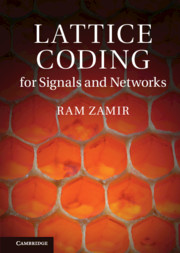 Lattice Coding for Signals and Networks
Lattice Coding for Signals and Networks Book contents
- Frontmatter
- Dedication
- Contents
- Preface
- Acknowledgements
- List of notation
- 1 Introduction
- 2 Lattices
- 3 Figures of merit
- 4 Dithering and estimation
- 5 Entropy-coded quantization
- 6 Infinite constellation for modulation
- 7 Asymptotic goodness
- 8 Nested lattices
- 9 Lattice shaping
- 10 Side-information problems
- 11 Modulo-lattice modulation
- 12 Gaussian networks
- 13 Error exponents
- Appendix
- References
- Index
9 - Lattice shaping
Published online by Cambridge University Press: 05 August 2014
- Frontmatter
- Dedication
- Contents
- Preface
- Acknowledgements
- List of notation
- 1 Introduction
- 2 Lattices
- 3 Figures of merit
- 4 Dithering and estimation
- 5 Entropy-coded quantization
- 6 Infinite constellation for modulation
- 7 Asymptotic goodness
- 8 Nested lattices
- 9 Lattice shaping
- 10 Side-information problems
- 11 Modulo-lattice modulation
- 12 Gaussian networks
- 13 Error exponents
- Appendix
- References
- Index
Summary
As information theory shows, Gaussian sources and channels should be encoded using “Gaussian codebooks.” A Gaussian variable maximizes the entropy for a given second moment. For source coding, this implies that a Gaussian codebook optimizes the volume-distortion and volume-overload trade-offs; for channel coding, it optimizes the volume-error and volume-power trade-offs. A Gaussian codebook has a Gaussian – or equivalently, spherical – shape, with roughly evenly spaced points as codewords. Can a lattice code replace a Gaussian codebook?
In variable-rate (entropy-coded) quantization (Chapter 5) and in non-uniform signaling (Chapter 6), the codebook is the whole (unbounded) lattice, and is not truncated to fit the source variance or the transmission power constraint. The lack of shaping is compensated for by variable-rate coding, which amounts to probabilistic (“soft”) shaping: remote lattice points are rarely used so their effect on the average coding rate and power is negligible. Fixed-rate (or pick-amplitude constrained) coding, however, requires “hard” shaping, i.e., a bounded codebook.
In this chapter we examine the performance of a codebook (or constellation) whose codewords and shaping region both have a lattice structure, as described in Chapter 8. We saw earlier in Chapter 7 that for a large lattice dimension, the fundamental Voronoi region of a good lattice can approximate a ball; or equivalently, a uniform distribution on this region can approximate a white-Gaussian distribution.
Information
- Type
- Chapter
- Information
- Lattice Coding for Signals and NetworksA Structured Coding Approach to Quantization, Modulation and Multiuser Information Theory, pp. 197 - 246Publisher: Cambridge University PressPrint publication year: 2014